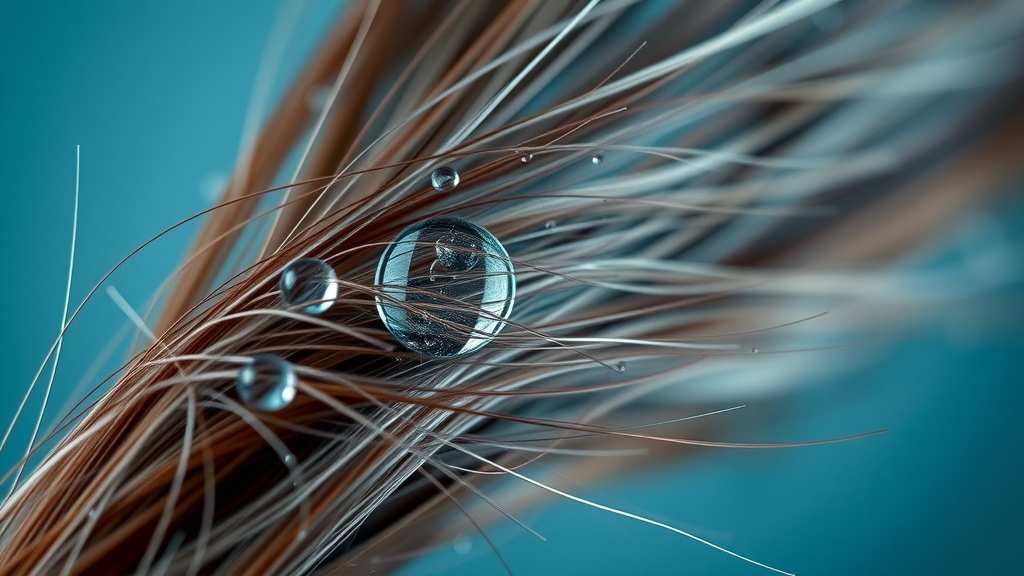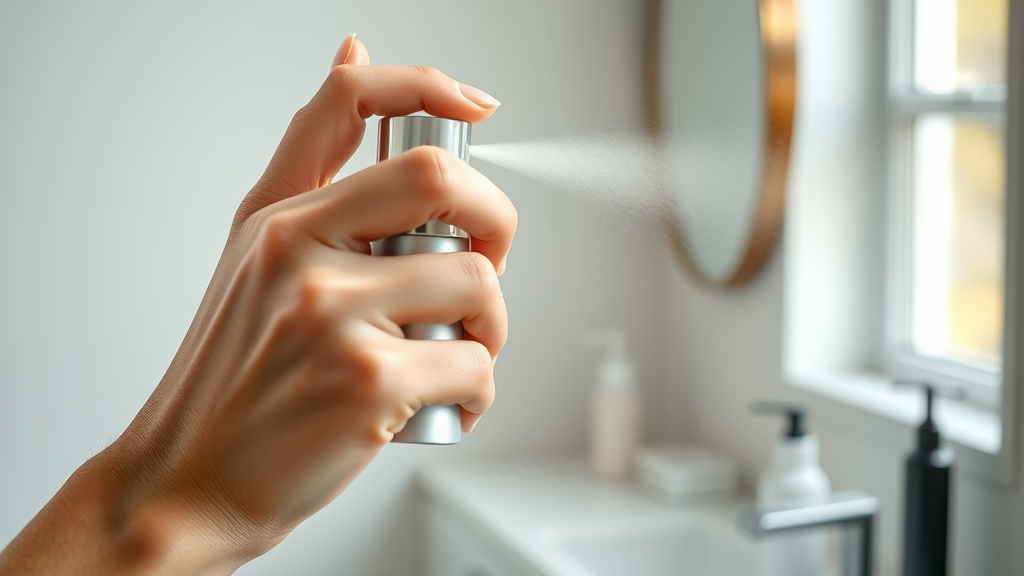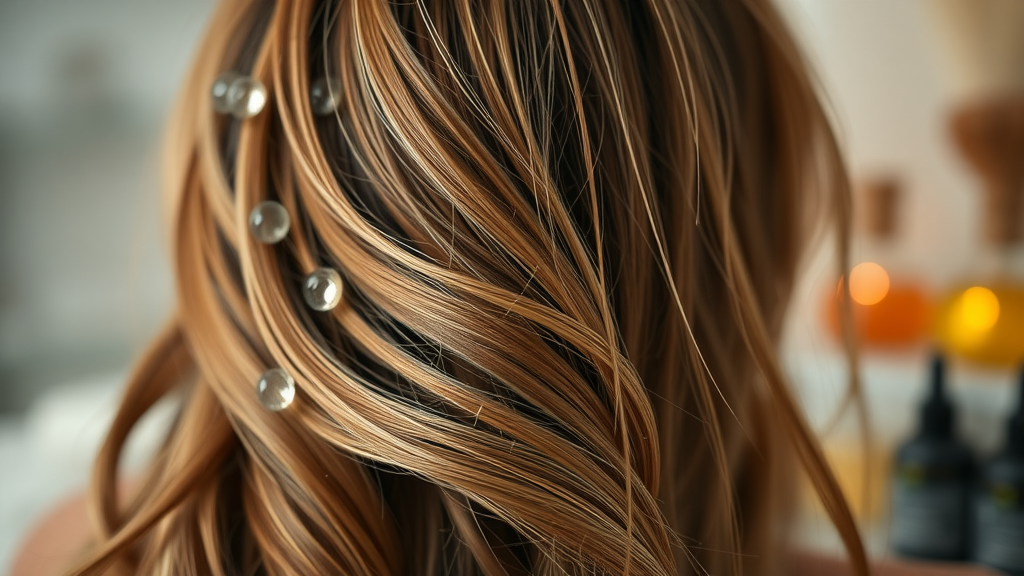Did you know that up to 70% of people experience frizzy hair during humid weather? Anyone who's battled flyaways on a sticky summer day knows the pain: your sleek, frizz control routine works perfectly—until you step outside. Suddenly, all your effort unravels, and your hair becomes a victim of the moisture in the air . The good news? You don’t have to accept frizzy hair days as your fate. Welcome to the ultimate list of humidity-fighting hair products that truly deliver sleek, smooth hair fast, no matter your hair type or climate. Scroll down to discover the best sprays, serums, and styling tips that finally keep your hair smooth—even when the weather refuses to cooperate.

Did You Know That Up to 70% of People Experience Frizzy Hair During Humid Weather?
Humidity triggers frizzy hair for nearly 7 in 10 people, infiltrating the hair shaft and disrupting even the most diligent styling. Why does this happen? When the air gets heavy with moisture, your hair's cuticle lifts, letting water molecules in and transforming smooth hair into a frizzy mess. This effect hits all hair types : from curly hair losing its curl definition, to straight hair puffing up, to dry hair feeling brittle and hard to manage.
Finding the right humidity-fighting hair products is a game-changer in humid weather. These products form a protective barrier around each strand—think of an invisible shield—locking in style and keeping out excess moisture that causes frizz. With advanced formulas (hello, humidity spray , heat protectant , and smoothing spray !), anyone can enjoy good hair days all year, not just on dry, crisp afternoons.
Why Humidity-Fighting Hair Products Are a Game Changer for All Hair Types
Choosing the right hair product isn't just a luxury—it's your best defense against pesky humidity. Humidity-fighting hair products contain innovative ingredients that seal the hair cuticle , trapping hydration where you want it and keeping frizzy hair at bay. This technology isn't limited by your hair type ; it's ideal for curly hair craving curl definition, dry hair seeking moisture, and fine hair needing lightweight protection that won’t cause flatness.
Forget one-size-fits-all solutions. These specialized products—ranging from sprays to serums and creams—offer targeted benefits like frizz protection , heat protection from styling appliances, and even ingredients like jojoba oil or coconut oil that enhance shine. The best part? They're faster and more effective than ever, so your hair stays glossy and controlled in minutes.
"Humidity is the silent enemy of sleek, healthy hair—choosing the right hair products can make all the difference." – Celebrity Stylist
What You Can Expect to Learn About Humidity-Fighting Hair Products
- The science behind how humidity affects hair
- Top features and ingredients in humidity-fighting hair products
- Quick tips for lasting smoothness in humid weather
- How to choose the right product for your hair type

Best Humidity-Fighting Hair Products: Tried, Tested & Ranked
| Product Name | Best For | Key Benefits | Frizz Control Rating | Price |
|---|---|---|---|---|
| Bumble and Bumble Hairdresser’s Invisible Oil | All Hair Types | Lightweight, UV & heat protectant, humidity spray | 10/10 | $$$ |
| Living Proof No Frizz Humidity Shield | Fine to Thick Hair | Protects from humid weather, easy reapplication | 9.5/10 | $$ |
| Aussie Smooth Humidity Spray | Curly Hair | Intense frizz control, adds shine | 9/10 | $ |
| Oribe Impermeable Anti-Humidity Spray | All Hair Types | Smoothing spray, heat protection, reduces frizz | 9/10 | $$$ |
| John Frieda Frizz Ease Moisture Barrier | Dry/Frizzy Hair | Frizz protection, adds shine | 8.5/10 | $ |
1. Bumble and Bumble Hairdresser’s Invisible Oil - The Ultimate Humidity Spray for Frizz Control
- Works as both a heat protectant and a humidity spray
- Great for all hair types including curly hair and dry hair
- Adds shine while providing frizz protection
- Smells luxurious and is easy to apply
When it comes to battling humid weather, the Bumble and Bumble Hairdresser’s Invisible Oil stands at the top. This humidity-fighting hair product is celebrated for its dual protection: not only does it work as a heat protectant for those who style with a hot tool, but it's also a powerful humidity spray that shields against frizzy hair. Its lightweight formula coats each hair strand with nourishing oils such as jojoba oil and coconut oil, sealing the cuticle for long-lasting smoothness.
The Invisible Oil leaves hair feeling soft and manageable, regardless of your hair type. Many users rave about how it adds shine , smells great, and keeps their hair smooth without buildup. This is especially true for people who want a product that is easy to layer with other styling treatments or reapply on the go.

2. Living Proof No Frizz Humidity Shield - Frizz Protection for Humid Weather
- Delivers instant results against humid weather
- Designed for various hair types; particularly effective for frizzy hair
- Can be reapplied throughout the day for consistent frizz control
If you’re looking for a hair product that makes an immediate difference, Living Proof No Frizz Humidity Shield is a must-have. Formulated with advanced anti-humidity technology , it forms a lightweight, invisible barrier on your hair cuticle, repelling moisture in the air. This is essential for both straight and curly hair that tends to lose structure or curl definition in sticky weather.
What makes it stand out among humidity-fighting hair products is its ease of use. The spray can be reapplied throughout your day without causing buildup or stiffness—perfect for touch-ups on the go. With consistent use, you’ll notice improved frizz control, enhanced shine, and hair that stayed sleek despite even the dampest climates.
3. Aussie Smooth Humidity Spray - Affordable Frizz Control for Curly Hair
- Budget-friendly humidity-fighting hair product
- Locks out moisture and reduces frizz, especially in dry hair
- Perfect for curls prone to frizz during humid weather
Don’t let your budget hold you back from smooth hair. Aussie Smooth Humidity Spray delivers exceptional frizz protection for everyone—especially those with curly hair. This formula is designed to lock out the damaging effects of humid weather, keeping curls bouncy, defined, and vibrant.
One of the standout features is its curl definition power thanks to nourishing ingredients and an effective humidity spray base. Applying it to damp or dry hair results in noticeable reduction in frizzy hair , more shine, and extreme manageability, even for dry hair prone to tangles. Perfect for anyone looking for a humidity-fighting hair product that won’t weigh down curls.

4. Oribe Impermeable Anti-Humidity Spray - Salon-Quality Humidity Spray
- Smoothing spray with strong frizz protection
- Adds shine and acts as a heat protectant
- Suitable for any hair type exposed to windy, humid weather
Salon-quality frizz protection is at your fingertips with Oribe Impermeable Anti-Humidity Spray . This award-winning smoothing spray is renowned for its ability to instantly tame flyaways and keep hair polished—even when the humidity spikes. Fine, dry, or curly hair can all benefit from its advanced formula, which combines heat protection with a humidity shield to maintain your chosen style.
Users love its barely-there finish, the boost it gives to shine, and the fact it works well whether you let your hair air dry or add heat styling into your routine. Oribe’s salon-level results are truly hard to beat when you need a humidity-fighting hair product to take you from steamy mornings to breezy evening events.
5. John Frieda Frizz Ease Moisture Barrier - Moisture-Locking Hair Product for Humidity
- Specialist formula for combating humid weather
- Works well for dry hair and frizzy hair
- Protects style while enhancing shine
When your hair needs intense moisture-locking action, the John Frieda Frizz Ease Moisture Barrier is a budget-friendly solution that produces incredible results. A long-time favorite among humidity-fighting hair products, it’s designed to provide a solid protective barrier against moisture in the air , keeping styles crisp and defined. It’s especially effective for dry hair that tends to become frazzled and lose shape in the summer heat.
This spray is perfect for enhancing shine and maintaining control without stickiness—users often report that their hair stayed touchably smooth, even through long, humid days. Add this product into your regular styling routine alongside a reliable heat protectant, and you’ll see why so many consider it the “secret weapon” for humid weather.
How to Choose the Best Humidity-Fighting Hair Products for Your Hair Type
- Consider your hair type: curly hair, straight, fine, dry hair needs
- Look for labels with ‘humidity spray’, ‘heat protectant’, or ‘frizz control’
- Read ingredient lists for silicone, argan oil, and anti-humidity technology

Picking the perfect humidity-fighting hair product is about matching your hair type with the right formula. If you have curly hair , you’ll want sprays that emphasize curl definition and lock out moisture. For dry hair , look for products packed with hydrating oils and humectants. Fine or straight hair types will benefit from lighter sprays that provide strong frizz control without excess weight.
Always read the ingredient list. Reliable products often feature silicone for a smooth finish, argan oil for moisture, or other anti-humidity technologies designed to seal the hair cuticle. Check for labels like ‘ humidity spray ’, ‘ heat protectant ’, ‘ frizz protection ’, or ‘adds shine’ to ensure you’re choosing a product that won’t compromise your style, even on the hottest, muggiest days.
Curly Hair: Best Hair Products and Humidity Sprays
- Benefits of humidity-fighting sprays for curly hair
- Frizz protection and shape retention tips
Curly hair is often the most affected by humid weather, as the open cuticle absorbs moisture and causes curls to frizz and lose definition. Humidity-fighting sprays tailored for curls can be a lifesaver. These products help seal the hair shaft, reduce puffiness, and provide lasting curl definition. Many of the best formulas offer added moisture, which keeps the hair healthy and protected in sticky conditions.
For optimal frizz protection, look for sprays enriched with nourishing oils and humidity-blocking technology. Apply products to damp hair and style with a diffuser for bouncy curls, or use as a finishing spray to lock in your style. Pair your humidity spray with a moisturizing leave-in conditioner for extra softness and longevity, ensuring curls stay smooth and well-formed all day.
Dry Hair: Hydrating Hair Products That Resist Humid Weather
- Why moisture is key for dry hair in humid weather
- Top recommended humidity-fighting hair products
Dry hair is uniquely vulnerable to humidity, as it naturally seeks to absorb excess moisture from the air—resulting in unwanted frizz and a rough, brittle texture. That’s why hydration should be the foundation of your anti-humidity hair routine. Opt for humidity-fighting hair products rich in oils (like coconut oil or jojoba oil ), vitamin E, and moisture-sealing silicones; these ingredients replenish lost hydration and lock it in.
Apply a hydrating serum or cream to damp hair before using a heat protectant or styling spray. Your hair will not only withstand humid weather but will also feel softer, shinier, and much easier to manage. Top choices include sprays and creams from brands like Bumble and Bumble, John Frieda, and Living Proof—each designed to quench dry hair and prevent frizz for hours.

Fine and Straight Hair: Lightweight Anti-Humidity Options
- Avoiding weigh-down while gaining frizz protection
- Best smoothing sprays for straight hair
People with fine or straight hair often worry about heavy products that cause limp, oily-looking locks. The secret to successful humidity-fighting hair products for these hair types is choosing feather-light sprays or serums that provide strong hold without greasiness. Look for ‘ humidity spray ’ labels that specify “weightless” or “ultra-light,” and prefer formulas containing micro-silicones or anti-humidity polymers.
Smoothing sprays such as Living Proof’s Humidity Shield and Oribe’s Impermeable Anti-Humidity Spray are ideal choices, as they offer both heat protection and frizz control. Fine, straight hair gains shine and protection—but retains its body and bounce. These products also layer well under styling creams and finishers, ensuring your “good hair day” holds strong from morning until night.
Pro Application Tips for Humidity-Fighting Hair Products
- How to apply for maximum humidity protection
- Combining products for heat protection and frizz control
- Tips for long-lasting style in humid weather
For the best results with any humidity-fighting hair product, application is just as important as the formula itself. Start with clean, towel-dried hair and spray your chosen humidity spray evenly from roots to ends. If you use hot tools, follow with a heat protectant spray or cream, ensuring every strand is coated for overall heat protection and frizz control .
Layering a smoothing spray or lightweight serum as a finishing touch helps lock in your style and provides a final shield against moisture in the air . Avoid overloading products; instead, use a light hand and reapply sprays as needed during the day. For days with extreme humidity, carry a mini humidity spray in your bag for quick touch-ups that keep hair smooth and glossy.
Styling Routine: When and How to Layer Humidity-Fighting Hair Products
- Step-by-step regimen from washing to finish with hair product
- Ensuring proper use of heat protectant and humidity spray
- Product layering without build-up
| Step | Product Type | Function |
|---|---|---|
| 1 | Humidity spray | Shields strands, frizz control |
| 2 | Smoothing spray | Adds shine, frizz protection |
| 3 | Heat protectant | Guards against styling tools |

Frequently Asked Questions About Humidity-Fighting Hair Products
What product protects hair from humidity?
Humidity-fighting hair products like humidity spray , serums, and leave-in conditioners create a protective barrier over the hair cuticle. Top picks include Bumble and Bumble Hairdresser's Invisible Oil and Living Proof No Frizz Humidity Shield. These products block excess moisture, preserving smooth hair and preventing frizzy hair, even in high humidity conditions.
What is the best product to stop hair frizzing in humidity?
The best products to prevent hair frizz in humidity are multi-action sprays with ingredients that seal the hair shaft , add shine, and lock out moisture from the air. Look for options like Oribe Impermeable Anti-Humidity Spray and John Frieda Frizz Ease Moisture Barrier. Regular use keeps hair smooth, manageable, and glossy through any weather.

What hair products are good for humid weather?
Hair products labeled as humidity spray , heat protectant , or frizz control are best for humid weather. Choose those with lightweight formulas for fine hair and more nourishing creams for curly or dry hair. Consistent use provides frizz protection , heat protection, and helps add shine while ensuring your style lasts.
How can I stop humidity from affecting my hair?
To stop humidity from ruining your look, regularly apply a trusted humidity-fighting hair product like a leave-in spray or anti-frizz serum after each wash. Always prep with a heat protectant , air dry or blow dry gently, and layer a smoothing spray for extra defense. Touch up with a lightweight humidity spray throughout the day as needed.
Expert Tips for Long-Lasting Results With Humidity-Fighting Hair Products
- Always prep with a heat protectant to avoid damage
- Apply humidity-fighting sprays to both damp and dry hair
- Finish with a light smoothing spray to lock style
"Consistency and the right hair product pairing are the secrets to flawless hair in any climate." – Professional Hair Stylist
Your Next Step: Sleek, Frizz-Free Hair in Any Humid Weather
- Don’t let humid weather dictate your hair days
- Try one of our top humidity-fighting hair products and experience fast, visible results
- Discover more expert hair styling tips and recommended products in our product reviews
When battling frizz in humid conditions, selecting the right products is essential. The article “After much testing on our frizz-prone hair, we deem these the 9 best hair products for humidity” offers a comprehensive review of top-performing anti-humidity hair products, including the Color Wow Dream Coat and Amika’s leave-in treatment, both praised for their durability and heat protection. ( womanandhome.com ) Additionally, “The 8 Best Anti-Humidity Hair Products, Tested By Hairstylists” provides expert recommendations, highlighting products like the SheaMoisture Deep Treatment Hair Mask and Living Proof No Frizz Smooth Styling Cream, which are tailored to various hair types and needs. ( womenshealthmag.com ) Exploring these resources can help you find effective solutions to maintain sleek, frizz-free hair, regardless of the weather.
 Add Row
Add Row  Add
Add 




Write A Comment